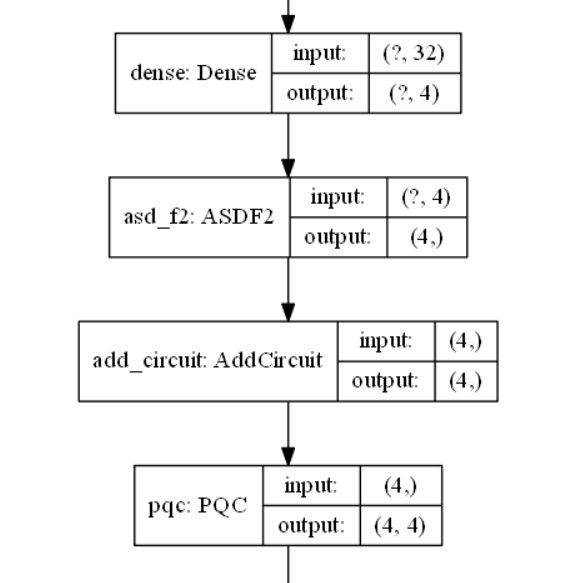Training: Passing tensors from tf to tfq using cirq to train
See original GitHub issueHello
Is there a way to pass a tensor in a form that is usable by cirq when it is passed from an upstream layer during training?
I have a tensor from a Dense layer. I want to run it through a custom layer and perform some tensor operations. This layer then outputs/returns a cirq circuit I designed. We can remove the functions in the layer or the layer entirely to make the problem more clear. Is there a way to pass a tensor into a cirq circuit using tfq/tf/cirq so that it can be trained?
I was assuming that since tensorflow is graph based none of the values would be accessible for training (i.e. you cannot get_weights() or evaluate the network in the middle of training to produce a numpy array/float value to pass into the circuit. Is there any way to go about this from any of the packages inside of tfq/tf/cirq/keras? I have tried using an tfq.layers.Expectation() by passing the tensor as the initializer. I have tried to find a solution to this using cirq functions as well but have not had success. Was thinking of also posting this in the cirq issues but (at least right now) believe this is more related to tfq than cirq.
Please let me know if there is anything below that is unclear or needs further explanation. Thanks in advance.
Code
I have tried to input a tensor into cirq and gotten this:
place = tf.compat.v1.placeholder(tf.float32, shape=(4,1))
placeholder = cirq.ry(place)(cirq.GridQubit(0,0))
placeholder ## -> cirq.ry(np.pi*<tf.Tensor 'truediv_25:0' shape=(4, 1) dtype=float32>).on(cirq.GridQubit(0, 0))
When it is embedded inside of a circuit and called like this it gives an error:
circuit1 = cirq.Circuit()
circuit1.append(cirq.ry(place)(cirq.GridQubit(0,0)))
circuit1 ## ->TypeError: int() argument must be a string, a bytes-like object or a number, not 'Tensor'
TypeError: can't pickle _thread.RLock objects
The functions from the layer: GetAngles3(weights): creates tensors with shape=(4,) CreateCircuit2(x): creates a cirq circuit using tfq.convert_to_tensor ` following the documetation
Here is the layer itself:
class ASDF2(tf.keras.layers.Layer):
def __init__(self, outshape=4, qubits=cirq.GridQubit.rect(1, 4)):
super(ASDF2, self).__init__()
self.outshape = outshape
self.qubits = qubits
def build(self, input_shape):
self.kernel = self.add_weight(name='kernel',
shape=(int(input_shape[1]), self.outshape),
trainable=True)
super(ASDF2, self).build(input_shape)
def call(self, inputs, **kwargs):
try:
x = GetAngles3(inputs)
y = CreateCircuit2(x)
return y
except:
x = tf.dtypes.cast(inputs, tf.dtypes.string)
return tf.keras.backend.squeeze(x, 0)
class ASDF2(tf.keras.layers.Layer):
def __init__(self, outshape=4, qubits=cirq.GridQubit.rect(1, 4)):
super(ASDF2, self).__init__()
self.outshape = outshape
self.qubits = qubits
def build(self, input_shape):
self.kernel = self.add_weight(name='kernel',
shape=(int(input_shape[1]), self.outshape),
trainable=True)
super(ASDF2, self).build(input_shape)
def call(self, inputs, **kwargs):
try:
x = GetAngles3(inputs)
y = CreateCircuit2(x)
return y
except:
x = tf.dtypes.cast(inputs, tf.dtypes.string)
return tf.keras.backend.squeeze(x, 0)
Here is the output when the model runs:
Train on 78 samples, validate on 26 samples
Epoch 1/25
****************inputs
Tensor("model/dense/Sigmoid:0", shape=(None, 4), dtype=float32)
****************GetAngles
Tensor("model/dense/Sigmoid:0", shape=(None, 4), dtype=float32)
[<tf.Tensor 'model/asd_f2/Asin:0' shape=(None, 4) dtype=float32>, <tf.Tensor 'model/asd_f2/mul:0' shape=(None, 4) dtype=float32>, <tf.Tensor 'model/asd_f2/mul_1:0' shape=(None, 4) dtype=float32>, <tf.Tensor 'model/asd_f2/mul_2:0' shape=(None, 4) dtype=float32>, <tf.Tensor 'model/asd_f2/mul_3:0' shape=(None, 4) dtype=float32>]
****************createCircuit
WARNING:tensorflow:Gradients do not exist for variables ['conv1d/kernel:0', 'conv1d/bias:0', 'dense/kernel:0', 'dense/bias:0', 'asd_f2/kernel:0'] when minimizing the loss.
****************inputs
Tensor("model/dense/Sigmoid:0", shape=(None, 4), dtype=float32)
****************GetAngles
Tensor("model/dense/Sigmoid:0", shape=(None, 4), dtype=float32)
[<tf.Tensor 'model/asd_f2/Asin:0' shape=(None, 4) dtype=float32>, <tf.Tensor 'model/asd_f2/mul:0' shape=(None, 4) dtype=float32>, <tf.Tensor 'model/asd_f2/mul_1:0' shape=(None, 4) dtype=float32>, <tf.Tensor 'model/asd_f2/mul_2:0' shape=(None, 4) dtype=float32>, <tf.Tensor 'model/asd_f2/mul_3:0' shape=(None, 4) dtype=float32>]
****************createCircuit
WARNING:tensorflow:Gradients do not exist for variables ['conv1d/kernel:0', 'conv1d/bias:0', 'dense/kernel:0', 'dense/bias:0', 'asd_f2/kernel:0'] when minimizing the loss.
Here is a plot of the model where ASDF2 is the layer I created:

Issue Analytics
- State:
- Created 3 years ago
- Reactions:1
- Comments:17 (1 by maintainers)

 Top Related StackOverflow Question
Top Related StackOverflow Question
Ok, turns out that the error was indeed a good old fashioned shape mismatch. I added a little snippet in the notebook to show where:
Output of the above is
(None, 34)and(8,12)(or something). The 2nd dim’s need to line up so that every free symbol has exactly one value to be placed inside of it.Does this clear things up now ?
Glad I was able to help clear things up 😃
You can pass whatever you want into tensorflow compute graphs as inputs. It’s OK to pass associated classical information to go along with your quantum circuits. I would just be careful to not accidentally do all the learning on a classical only model that just learns to ignore the harder to learn quantum parts.
I would check out this: https://www.tensorflow.org/quantum/api_docs/python/tfq/layers/Expectation which goes over how
tfq.layers.Expectationworks and the types of tensor input formats it can accept.tfq.layers.Expectationis a little more low level than aPQC/ControlledPQClayer so in the case where you need a little more fine grained control it can help out a lot.